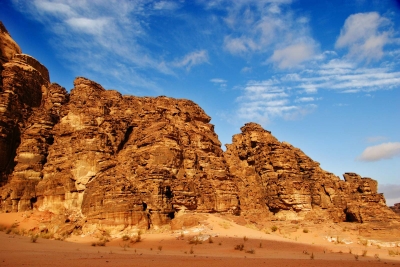
Covering almost the whole of the Arabian Peninsula, the Arabian Desert is the largest desert of Asia and among the world’s largest. Located on the southwestern part of the continent, the desert spans about 23,00,000 sq.km. Though the largest part of the desert lies in Saudi Arabia, it also spills over to other countries such as Yemen, Oman, United Arab Emirates, Kuwait, Qatar, Iraq, Israel, Egypt, and Jordan. Rub al-Khali, which makes up the most part of this desert, is the largest continuous area of sand in the world. Though the Arabian Desert gives the impression of simply being a sand-covered expanse, it is not really so. It supports a great variety of trees and plants such as succulents and palms adapted well to salt water or to limited availability of water. The central portion of the desert supports a number of herbs and flowering plants. All these, in turn, nurture several types of animals, birds, reptiles, and insects found in the region. Among the threats facing the desert are grazing, development projects, and oil surveys.
Wildlife
Dominating the landscape are numerous desert insects, including mosquitoes, fleas, ants, termites, beetles, locusts, spiders, butterflies, and caterpillars. Scorpions, salamanders, frogs, toads, lizards, geckos, and vipers too are found in the region. Among the birds seen here are both resident and migrant species such as larks, sandgrouses, coursers, bustards, falcons, kestrels, ravens, eagles, vultures, kites, warblers, babblers, bee eaters, swallows, martins, swifts, wheatears, flycatchers, starlings, and hoopoes. The mammals that can be spotted in the area include gazelles, oryx ibex foxes, civets, hyenas, jackals, jerboas, hares, porcupines, mice, hedgehogs, and baboons.
Threats
As mentioned earlier, development is a huge problem in the Arabain Desert. But there’s an equally, or perhaps, even a greater threat to the region-desertification. Arable land is land that can be put to good agricultural use. Desertification is the process in which productive drylands lose their ability to do so, due to climate change and/ or human activity. And that’s what’s happening in the Arabian Desert-arable land is turning into desert at an alarming rate. According to reports from just a couple of years ago, “70-90% of the Arabian Peninsula under threat of desertification”. Among the reasons attributed to this is the use of chemicals and pesticides in agriculture. As it is the environment has been harsh due to very high temperatures, low rainfall, and high humidity. But this is now aggravated due to climate change. Desertification also leads to extreme drought, floods, and even food shortage. Ever since oil was discovered in the region, settlements increased, adding stress to lands. Subsequent increase in livestock numbers and overgrazing led to further land degradation, and even loss of biodiversity. If this continues without any long-term solution or immediate intervention and remedial action, it would lead not just to continued loss of biodiversity but will impact even the people in the region negatively.
Picture Credit : Google




